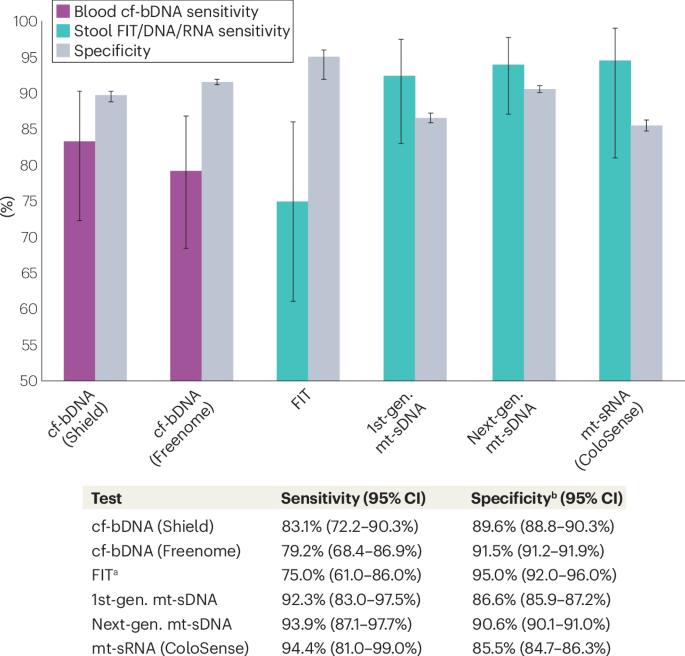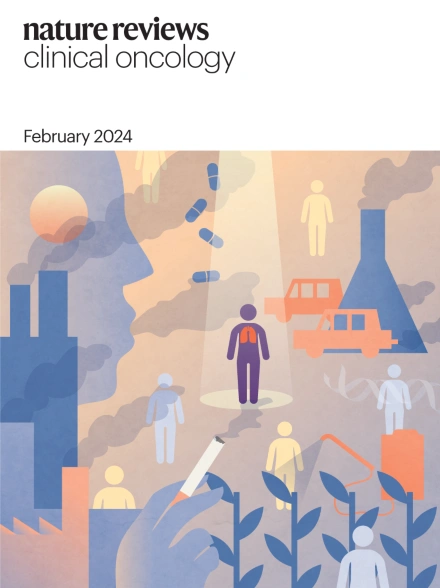新型结直肠癌筛查方法——机遇与挑战
IF 82.2
1区 医学
Q1 ONCOLOGY
引用次数: 0
摘要
在全球范围内,结直肠癌(CRC)是癌症死亡的第二大原因,也是第三大常见癌症。结直肠癌开始为腺瘤状或锯齿状息肉,特别是晚期前体病变(apl),有可能发展为侵袭性癌症。筛查结直肠癌有助于早期发现和识别更容易治愈的癌症,也可以发现和切除前驱病变,从而预防结直肠癌。结肠镜检查是筛查在美国的中流砥柱,具有明显的优势,使检测和去除前体病变。然而,结肠镜检查是繁重的,昂贵的和侵入性的,往往是阴性的结果。非侵入性检查,如检测粪便样本的生物风险标志物,有可能识别出更有可能从结肠镜检查中受益的个体。从公共卫生的角度来看,改善对筛查的遵守情况仍然是一个优先事项。技术创新,包括改进粪便检测的新标记的出现和检查无细胞DNA的血液检测的发展,有可能提高筛查的吸收和有效性。在接受筛查测试、检测癌症和重要的前驱病变(如api)与成本之间进行权衡,是一个复杂的计算。在这篇综述中,我们描述了CRC筛查的现状,并评估了筛查新进展的风险和益处。本文章由计算机程序翻译,如有差异,请以英文原文为准。


Novel colorectal cancer screening methods — opportunities and challenges
Globally, colorectal cancer (CRC) is the second leading cause of cancer death and the third most common incident cancer. CRC begins as adenomatous or serrated polyps, and in particular as advanced precursor lesions (APLs), which have the potential to progress into invasive cancers. Screening for CRC facilitates early detection and can identify cancers more amenable to cure, and can also detect and remove precursor lesions, thus also preventing CRC. Colonoscopy is the mainstay of screening in the USA and has the distinct advantage of enabling both detection and removal of precursors lesions. However, colonoscopy is burdensome, expensive and invasive, and often has negative findings. Non-invasive tests, such as testing stool samples for biomarkers of risk, have the potential to identify individuals who are more likely to benefit from colonoscopy. From a public health perspective, improving compliance with screening remains a priority. Technological innovations, including the emergence of new markers to improve stool testing and the development of blood tests that examine cell-free DNA have the potential to improve screening uptake and effectiveness. The trade-off between uptake of screening testing, detection of cancer and important precursor lesions such as APLs, and costs make for a complex calculus. In this Review, we describe the current state of CRC screening and evaluate the risks and benefits of new developments in screening. Despite being the second most lethal and the third most prevalent form of cancer, most cases of colorectal cancer (CRC) can be either detected at an early stage or prevented using screening colonoscopy with removal of precursor lesions. Nonetheless, universal colonoscopy is expensive and time consuming, and can be unpopular. Other less-invasive screening tests involving either faeces or more recently blood samples have the potential to improve overall CRC screening uptake and are an active area of research and development. In this Review, the authors describe the clinical utility of novel CRC screening methods such as multitarget stool DNA tests and blood cell-free DNA tests, including both the challenges and opportunities arising from their implementation.
求助全文
通过发布文献求助,成功后即可免费获取论文全文。
去求助
来源期刊
CiteScore
99.40
自引率
0.40%
发文量
114
审稿时长
6-12 weeks
期刊介绍:
Nature Reviews publishes clinical content authored by internationally renowned clinical academics and researchers, catering to readers in the medical sciences at postgraduate levels and beyond. Although targeted at practicing doctors, researchers, and academics within specific specialties, the aim is to ensure accessibility for readers across various medical disciplines. The journal features in-depth Reviews offering authoritative and current information, contextualizing topics within the history and development of a field. Perspectives, News & Views articles, and the Research Highlights section provide topical discussions, opinions, and filtered primary research from diverse medical journals.

 求助内容:
求助内容: 应助结果提醒方式:
应助结果提醒方式:


